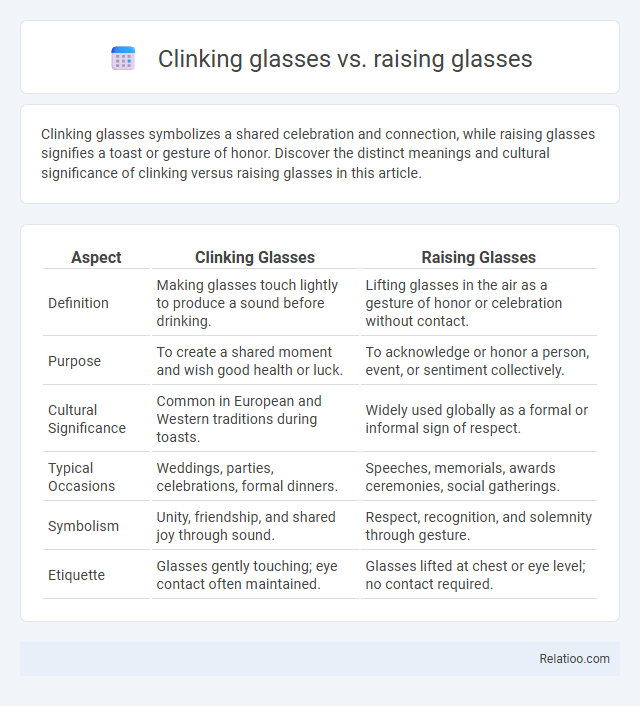Clinking glasses symbolizes a shared celebration and connection, while raising glasses signifies a toast or gesture of honor. Discover the distinct meanings and cultural significance of clinking versus raising glasses in this article.
Table of Comparison
| Aspect | Clinking Glasses | Raising Glasses |
|---|---|---|
| Definition | Making glasses touch lightly to produce a sound before drinking. | Lifting glasses in the air as a gesture of honor or celebration without contact. |
| Purpose | To create a shared moment and wish good health or luck. | To acknowledge or honor a person, event, or sentiment collectively. |
| Cultural Significance | Common in European and Western traditions during toasts. | Widely used globally as a formal or informal sign of respect. |
| Typical Occasions | Weddings, parties, celebrations, formal dinners. | Speeches, memorials, awards ceremonies, social gatherings. |
| Symbolism | Unity, friendship, and shared joy through sound. | Respect, recognition, and solemnity through gesture. |
| Etiquette | Glasses gently touching; eye contact often maintained. | Glasses lifted at chest or eye level; no contact required. |
Introduction: The Rituals of Toasting
Clinking glasses, raising glasses, and toasting are distinct yet intertwined customs deeply rooted in social traditions worldwide. Clinking glasses typically involves a gentle tap to signify mutual respect or celebration, while raising glasses serves as a visual cue of collective participation. Toasting combines both gestures with spoken words to honor a person, event, or sentiment, reinforcing social bonds through a shared ritual.
Historical Origins of Clinking vs Raising Glasses
Clinking glasses dates back to the Middle Ages, where the action was believed to ward off poisoning by mixing drinks through audible contact, reflecting a trust ritual. Raising glasses, however, has roots in ancient rituals and ceremonies symbolizing respect, unity, and celebration without the physical clink. Toasting, evolving from these traditions, combines the act of raising and often clinking glasses to honor a person or event with shared goodwill and communal bonding.
Cultural Differences in Toasting Traditions
Clinking glasses, raising glasses, and toasting hold distinct cultural significance across countries, reflecting diverse traditions and social norms. In Germany and France, clinking glasses is a ritual symbolizing unity and good fortune, while in Japan, raising glasses without clinking is customary, emphasizing respect and etiquette. Your understanding of these nuances enhances social interactions and shows appreciation for cultural diversity during celebratory moments.
Symbolism Behind Clinking Glasses
Clinking glasses symbolizes unity and shared celebration, creating a moment of connection and mutual respect among participants. This act dates back to ancient rituals where the sound was believed to ward off evil spirits and confirm trust. Unlike simply raising glasses or giving a toast, clinking combines visual and auditory elements that enhance the communal experience and reinforce social bonds.
Significance of Raising Glasses Without Clinking
Raising glasses without clinking holds a meaningful cultural significance, symbolizing respect, mindfulness, or solemnity in various traditions. Your choice to raise glasses silently can convey a deeper sense of honoring the moment or acknowledging spirits without the noise of clinking. This subtle gesture often emphasizes intention and connection over celebration, creating a personal and reflective atmosphere.
Etiquette Rules for Each Toasting Style
Clinking glasses requires gentle taps to avoid damage, maintaining eye contact with your companions as a sign of respect. Raising glasses involves lifting your drink to shoulder height or slightly higher without touching, often accompanied by a verbal expression to honor the occasion. During a toast, you should listen attentively and respond with a nod or smile, ensuring your words are clear and appropriate to the context.
When to Clink and When to Only Raise Glasses
Clinking glasses typically occurs during celebratory moments or social gatherings where participants want to symbolize unity and shared joy, often accompanied by eye contact before sipping the drink. Raising glasses without clinking is more appropriate in formal or solemn situations, such as memorials or respectful toasts, where maintaining decorum and focus on the words spoken takes precedence over physical interaction. Understanding the cultural context and the nature of the event helps determine whether to clink or simply raise glasses to honor tradition and etiquette.
Social Meanings and Misconceptions
Clinking glasses symbolizes mutual celebration and shared joy, often enhancing social bonding by creating a moment of connection. Raising glasses signifies respect and acknowledgment, commonly used to honor someone or something without necessarily making a verbal declaration. Toasting involves a spoken tribute or wish, which can be misunderstood as exclusive or formal; knowing these distinctions helps you navigate social gatherings with cultural sensitivity and avoid awkward interactions.
Modern Trends in Toasting Etiquette
Modern trends in toasting etiquette emphasize personalized and inclusive expressions, moving beyond traditional clinking glasses or simply raising them. You can elevate your social interactions by incorporating mindful eye contact and genuine words during a toast, reflecting sincerity and connection. Embracing these contemporary practices reinforces respect and warmth in celebratory moments.
Conclusion: Choosing the Right Gesture
Choosing the right gesture depends on the social setting and cultural context, as clinking glasses symbolizes unity and celebration, while raising glasses signifies respect and acknowledgment. A toast combines both actions with spoken words to honor an individual or occasion, making it the most formal and expressive option. Understanding these nuances ensures meaningful and appropriate expressions during social gatherings.

Infographic: Clinking glasses vs Raising glasses
 relatioo.com
relatioo.com